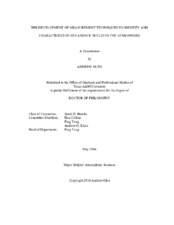| dc.contributor.advisor | Brooks, Sarah D | |
| dc.creator | Glen, Andrew | |
| dc.date.accessioned | 2015-01-09T19:58:01Z | |
| dc.date.available | 2016-05-01T05:31:02Z | |
| dc.date.created | 2014-05 | |
| dc.date.issued | 2014-01-15 | |
| dc.date.submitted | May 2014 | |
| dc.identifier.uri | https://hdl.handle.net/1969.1/152508 | |
| dc.description.abstract | Mineral dusts and ice crystals directly influence the Earth's radiative budget
through radiative scattering and absorption. The interaction of spherical particles on the
radiative budget are well known, however mineral dusts and ice crystals are generally
non-spherical leading to large uncertainties in the radiative impacts of these particles. In
addition, atmospheric dust has the ability to act as an Ice Nuclei (IN) aiding in the
formation of ice crystals in the atmosphere through four well known nucleation
mechanisms. The work presented here discusses new instrumentation and methods to
measure and identify both the optical scattering properties and ice nucleation properties
of atmospherically relevant dusts.
The Texas A&M University Continuous Flow Diffusion Chamber (CFDC) was
constructed and characterized in the laboratory using a known effective IN, silver iodide.
This instrument was then deployed in the Arctic as part of the Indirect Semi-Direct
Aerosol Campaign (ISDAC) where it measured the concentration of potential IN under
atmospheric conditions. The results of which, showed the Arctic has higher particle
concentrations during the spring compared to data collected in the fall during other field
projects. In addition, extreme nucleation events were observed with average IN
concentrations as high as 100 L^(-1).
The optical scattering properties of atmospherically relevant dusts were measured
using a prototype instrument, the Cloud Aerosol Spectrometer with Polarization
(CASPOL) under laboratory conditions. The data collected using this instrument allowed the classification of 13 atmospherically relevant dusts into 3 distinct groups based on the
optical scattering properties. This instrument was then upgraded by the manufacturer and
used to measure the optical scattering properties of both atmospherically relevant dusts
and ice crystals generated using the CFDC with the previously examined dusts as
potential IN. The results show the dusts can still be categorized into 3 distinct groups
and can be differentiated from generated ice crystals. These results provide
methodologies for differentiating atmospheric dust from ice crystals in the atmosphere
using remote sensing instrumentation. | en |
| dc.format.mimetype | application/pdf | |
| dc.language.iso | en | |
| dc.subject | Ice Nucleation | en |
| dc.subject | Optical Scattering Properties | en |
| dc.subject | Dust | en |
| dc.subject | Instrumentation | en |
| dc.title | The Development of Measurement Techniques to Identify and Characterize Dusts and Ice Nuclei in the Atmosphere | en |
| dc.type | Thesis | en |
| thesis.degree.department | Atmospheric Sciences | en |
| thesis.degree.discipline | Atmospheric Sciences | en |
| thesis.degree.grantor | Texas A & M University | en |
| thesis.degree.name | Doctor of Philosophy | en |
| thesis.degree.level | Doctoral | en |
| dc.contributor.committeeMember | Collins, Don | |
| dc.contributor.committeeMember | Yang, Ping | |
| dc.contributor.committeeMember | Klein, Andrew | |
| dc.type.material | text | en |
| dc.date.updated | 2015-01-09T19:58:01Z | |
| local.embargo.terms | 2016-05-01 | |


